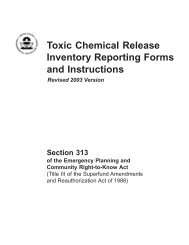(Lockout/Tagout) (revised 2002) OSHA 3120 - Seton
(Lockout/Tagout) (revised 2002) OSHA 3120 - Seton
(Lockout/Tagout) (revised 2002) OSHA 3120 - Seton
Create successful ePaper yourself
Turn your PDF publications into a flip-book with our unique Google optimized e-Paper software.
What if I use outside contractors for service<br />
or maintenance procedures?<br />
If an outside contractor services or maintains machinery,<br />
the onsite employer and the contractor must inform each other<br />
of their respective lockout or tagout procedures. The onsite<br />
employer also must ensure that employees understand and<br />
comply with all requirements of the contractor’s energy-control<br />
program(s).<br />
What if a group performs service or maintenance activities?<br />
When a crew, department, or other group performs service<br />
or maintenance, they must use a procedure that provides all<br />
employees a level of protection equal to that provided by<br />
a personal lockout or tagout device. Each employee in the<br />
group must have control over the sources of hazardous energy<br />
while he or she is involved in service and maintenance activities<br />
covered by the standard. Personal control is achieved when each<br />
authorized employee affixes a personal lockout/tagout device to<br />
a group lockout mechanism instead of relying on a supervisor<br />
or other person to provide protection against hazardous energy.<br />
Detailed requirements of individual responsibilities are provided<br />
in 29 CFR 1910.147(f)(3)(ii)(A) through (D). Appendix C of<br />
<strong>OSHA</strong> Directive STD 1-7.3, 29 CFR 1910.147, the Control of<br />
Hazardous Energy (<strong>Lockout</strong>/<strong>Tagout</strong>)-Inspection Procedures<br />
and Interpretive Guidance, (September 11, 1990), provides<br />
additional guidance.<br />
What if a shift changes during machine service or maintenance?<br />
Employers must make sure that there is a continuity of<br />
lockout or tagout protection. This includes the orderly transfer<br />
of lockout or tagout device protection between outgoing and<br />
incoming shifts to control hazardous energy. When lockout<br />
or tagout devices remain on energy-isolation devices from<br />
a previous shift, the incoming shift members must verify<br />
for themselves that the machinery is effectively isolated<br />
and deenergized.<br />
16<br />
Control of Hazardous Energy (<strong>Lockout</strong>/<strong>Tagout</strong>)
















